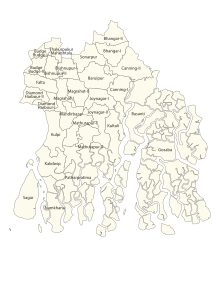Patharpratima | |
|---|---|
 Location of Patharpratima community development block in South 24 Parganas district | |
| Coordinates: 21°47′39″N88°21′20″E / 21.7941°N 88.3555°E | |
| Country | |
| State | |
| Division | Presidency |
| District | South 24 Parganas |
| Subdivision | Kakdwip |
| Headquarters | Ramganga |
| Government | |
| • Gram Panchayats | Achintyanagar, Banashyamnagar, Brajaballavpur, Dakshin Gangadharpur, Dakshin Raipur, Digambarpur, Durbachati, G Plot, Gopalnagar, Herambagopalpur, Laksmijanardanpur, Patharpratima, Ramganga, Sridharnagar, Srinarayanpur Purnachandrapur |
| • Lok Sabha constituencies | Mathurapur |
| • Vidhan Sabha constituencies | Patharpratima |
| Area | |
• Total | 484.47 km2 (187.05 sq mi) |
| Population (2011) | |
• Total | 331,823 |
| • Density | 680/km2 (1,800/sq mi) |
| Demographics | |
| • Literacy | 82.11 per cent |
| • Sex ratio | 959 ♂/♀ |
| Languages | |
| • Official | Bengali [1] [2] |
| • Additional official | English [1] |
| Time zone | UTC+05:30 (IST) |
| Website | s24pgs |
Patharpratima is a community development block that forms an administrative division in Kakdwip subdivision of South 24 Parganas district in the Indian state of West Bengal.




















